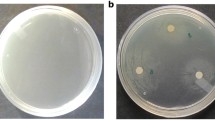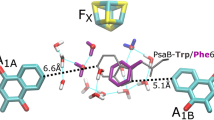Abstract
Vibrio cholerae cryptochrome-1 (VcCRY-1) is a member of the cryptochrome DASH family. The flavoprotein appears to use blue light both for repair of cyclobutane pyrimidine dimers (CPDs) on DNA and signal transduction. Earlier, we found that it was almost impossible to oxidize the FADH· state upon binding to a CPD, and, in the absence of substrate, the rate of FADH· oxidation was much larger at high pH (Gindt et al. in Biochemistry 54:2802–2805, 2015). Here, we present the pH-dependence of the oxidation of FADH· by ferricyanide, which revealed a switch between slow and fast oxidation with a pKa ≈ 7.0. Stopped-flow mixing was used to measure the oxidation of FADH− to FADH· at pH 6.7 and 7.5. Substrate binding was required to slow down this oxidation such that it could be measured with stopped flow, but there was only a small effect of pH. In addition, resonance Raman measurements of FADH· in VcCRY-1 at pH 6.5 and 7.5 were performed to probe for structural changes near the FAD cofactor related to the observed changes in rate of FADH· oxidation. Only substrate binding seemed to induce a change near the FAD cofactor that may relate to the change in oxidation kinetics. The pH-effect on the FADH· oxidation rate, which is rate-limited by the proton acceptor, does not seem to be due to a protein structural change near the FAD cofactor. Instead, a conserved glutamate in CRY-DASH may control the deprotonation of FADH· and give rise to the pH-effect.






Similar content being viewed by others
References
Kiontke, S., Goebel, T., Brych, A., & Batschauer, A. (2020). DASH-type cryptochromes—solved and open questions. Journal of Biological Chemistry, 401(12), 1487–1493. https://doi.org/10.1515/hsz-2020-0182
Fortunato, A. E., Annunziata, R., Jaubert, M., Bouly, J.-P., & Falciatore, A. (2015). Dealing with light: The widespread and multitasking cryptochrome/photolyase family in photosynthetic organisms. Journal of Plant Physiology, 172, 42–54.
Mueller, M., & Carell, T. (2009). Structural biology of DNA photolyases and cryptochromes. Current Opinion in Structural Biology, 19(3), 277–285. https://doi.org/10.1016/j.sbi.2009.05.003
Batschauer, A., Banerjee, R., & Pokorny, R. (2007). Cryptochromes. Annual Plant Review, 30, 17–48. (Light and Plant Development).
Brudler, R., Hitomi, K., Daiyasu, H., Toh, H., Kucho, K., Ishiura, M., et al. (2003). Identification of a new cryptochrome class: Structure, function, and evolution. Molecular Cell, 11, 59–67.
Ahmad, M. (2003). Cryptochromes and flavoprotein blue-light photoreceptors. In Handbook of photochemistry and photobiology, 4 (pp. 159–182). American Scientific Publishers.
Sancar, A. (2003). Structure and function of DNA photolyase and cryptochrome blue-light photoreceptors. Chemical Reviews, 103, 2203–2237.
Tagua, V. G., Pausch, M., Eckel, M., Gutierrez, G., Miralles-Duran, A., Sanz, C., et al. (2015). Fungal cryptochrome with DNA repair activity reveals an early stage in cryptochrome evolution. Proceedings of the National Academy of Sciences of the United States of America, 112(49), 15130–15135. https://doi.org/10.1073/pnas.1514637112
Ahmad, M. (2016). Photocycle and signaling mechanisms of plant cryptochromes. Current Opinion in Plant Biology, 33, 108–115. https://doi.org/10.1016/j.pbi.2016.06.013
Wang, J., Du, X., Pan, W., Wang, X., & Wu, W. (2015). Photoactivation of the cryptochrome/photolyase superfamily. Journal of Photochemistry and Photobiology C, 22, 84–102. https://doi.org/10.1016/j.jphotochemrev.2014.12.001
Mueller, P., Brettel, K., Grama, L., Nyitrai, M., & Lukacs, A. (2016). Photochemistry of wild-type and N378D mutant E. coli DNA photolyase with oxidized FAD cofactor studied by transient absorption spectroscopy. ChemPhysChem, 17(9), 1329–1340. https://doi.org/10.1002/cphc.201501077
Pokorny, R., Klar, T., Hennecke, U., Carell, T., Batschauer, A., & Essen, L.-O. (2008). Recognition and repair of UV lesions in loop structures of duplex DNA by DASH-type cryptochrome. Proceedings of the National Academy of Sciences of the United States of America, 105(52), 21023–21027. https://doi.org/10.1073/pnas.0805830106
Sokolowsky, K., Newton, M., Lucero, C., Wertheim, B., Freedman, J., Cortazar, F., et al. (2010). Spectroscopic and thermodynamic comparisons of Escherichia coli DNA photolyase and Vibrio cholerae cryptochrome 1. Journal of Physics and Chemistry B, 114(20), 7121–7130. https://doi.org/10.1021/jp102275r
Selby, C. P., & Sancar, A. (2006). A cryptochrome/photolyase class of enzymes with single-stranded DNA-specific photolyase activity. Proceedings of the National Academy of Sciences of the United States of America, 103, 17696–17700.
Garcia-Esquivel, M., Esquivel-Naranjo, E. U., Hernandez-Onate, M. A., Ibarra-Laclette, E., & Herrera-Estrella, A. (2016). The Trichoderma atroviride cryptochrome/photolyase genes regulate the expression of blr1-independent genes both in red and blue light. Fungal Biology, 120(4), 500–512. https://doi.org/10.1016/j.funbio.2016.01.007
Wang, F., Song, X., Dong, X., Zhang, J., & Dong, C. (2017). DASH-type cryptochromes regulate fruiting body development and secondary metabolism differently than CmWC-1 in the fungus Cordyceps militaris. Applied Microbiology Biotechnology, 101(11), 4645–4657. https://doi.org/10.1007/s00253-017-8276-7
Castrillo, M., Garcia-Martinez, J., & Avalos, J. (2013). Light-dependent functions of the Fusarium fujikuroi CryD DASH cryptochrome in development and secondary metabolism. Applied Environmental Microbiology, 79(8), 2777–2788. https://doi.org/10.1128/AEM.03110-12
Cohrs, K. C., & Schumacher, J. (2017). The two cryptochrome/photolyase family proteins fulfill distinct roles in DNA photorepair and regulation of conidiation in the gray mold fungus Botrytis cinerea. Applied Environmental Microbiology 83(17), e00812-00817/00818. https://doi.org/10.1128/AEM.00812-17.
Holub, D., Kubar, T., Mast, T., Elstner, M., & Gillet, N. (2019). What accounts for the different functions in photolyases and cryptochromes: A computational study of proton transfers to FAD. Physical Chemistry Chemical Physics, 21(22), 11956–11966. https://doi.org/10.1039/c9cp00694j
Xu, L., Mu, W., Ding, Y., Luo, Z., Han, Q., Bi, F., et al. (2008). Active site of Escherichia coli DNA photolyase: Asn378 is crucial both for stabilizing the neutral flavin radical cofactor and for DNA repair. Biochemistry, 47(33), 8736–8743. https://doi.org/10.1021/bi800391j
Damiani, M. J., Nostedt, J. J., & O’Neill, M. A. (2011). Impact of the N5-proximal Asn on the thermodynamic and kinetic stability of the semiquinone radical in photolyase. Journal of Biology and Chemistry, 286(6), 4382–4391. https://doi.org/10.1074/jbc.M110.194696
Muller, P., Brettel, K., Grama, L., Nyitrai, M., & Lukacs, A. (2016). Photochemistry of wild-type and N378D mutant E. coli DNA photolyase with oxidized FAD cofactor studied by transient absorption spectroscopy. ChemPhysChem, 17(9), 1329–1340.
Burney, S., Wenzel, R., Kottke, T., Roussel, T., Hoang, N., Bouly, J.-P., et al. (2012). Single amino acid substitution reveals latent photolyase activity in arabidopsis cry1. Angewandte Chemie International Edition, 51(37), 9356–9360. https://doi.org/10.1002/anie.201203476
Worthington, E. N., Kavakli, I. H., Berrocal-Tito, G., Bondo, B. E., & Sancar, A. (2003). Purification and characterization of three members of the photolyase/cryptochrome family blue-light photoreceptors from Vibrio cholerae. Journal of Biological Chemistry, 278(40), 39143–39154. https://doi.org/10.1074/jbc.M305792200
Immeln, D., Pokorny, R., Herman, E., Moldt, J., Batschauer, A., & Kottke, T. (2010). Photoreaction of plant and DASH cryptochromes probed by infrared spectroscopy: The neutral radical state of flavoproteins. The Journal of Physical Chemistry B, 114(51), 17155–17161. https://doi.org/10.1021/jp1076388
Berndt, A., Kottke, T., Breitkreuz, H., Dvorsky, R., Hennig, S., Alexander, M., et al. (2007). A novel photoreaction mechanism for the circadian blue light photoreceptor drosophila cryptochrome. Journal of Biological Chemistry., 282(17), 13011–13021. https://doi.org/10.1074/jbc.M608872200
Paulus, B., Bajzath, C., Melin, F., Heidinger, L., Kromm, V., Herkersdorf, C., et al. (2015). Spectroscopic characterization of radicals and radical pairs in fruit fly cryptochrome—protonated and nonprotonated flavin radical-states. FEBS Journal, 282(16), 3175–3189. https://doi.org/10.1111/febs.13299
Einholz, C., Nohr, D., Rodriguez, R., Topitsch, A., Kern, M., Goldmann, J., et al. (2021). pH-dependence of signaling-state formation in Drosophila cryptochrome. Archives of Biochemistry and Biophysics, 700, 108787. https://doi.org/10.1016/j.abb.2021.108787
Iwata, T., Zhang, Y., Hitomi, K., Getzoff, E. D., & Kandori, H. (2010). Key dynamics of conserved asparagine in a cryptochrome/photolyase family protein by fourier transform infrared spectroscopy. Biochemistry, 49(41), 8882–8891. https://doi.org/10.1021/bi1009979
Xu, L., Wen, B., Shao, W., Yao, P., Zheng, W., Zhou, Z., et al. (2019). Impacts of Cys392, Asp393, and ATP on the FAD binding, photoreduction, and the stability of the radical state of Chlamydomonas reinhardtii cryptochrome. ChemBioChem, 20(7), 940–948. https://doi.org/10.1002/cbic.201800660
Gindt, Y. M., Schelvis, J. P. M., Thoren, K. L., & Huang, T. H. (2005). Substrate binding modulates the reduction potential of DNA photolyase. Journal of the American Chemical Society, 127(30), 10472–10473. https://doi.org/10.1021/ja051441r
Schelvis, J. P. M., Ramsey, M., Sokolova, O., Tavares, C., Cecala, C., Connell, K., et al. (2003). Resonance Raman and UV–Vis spectroscopic characterization of FADH.bul. in the complex of photolyase with UV-damaged DNA. The Journal of Physical Chemistry B, 107(44), 12352–12362. https://doi.org/10.1021/jp034209l
Zieba, A. A., Richardson, C., Lucero, C., Dieng, S. D., Gindt, Y. M., & Schelvis, J. P. M. (2011). Evidence for concerted electron proton transfer in charge recombination between FADH- and 306Trp· in Escherichia coli photolyase. Journal of the American Chemical Society, 133(20), 7824–7836. https://doi.org/10.1021/ja2001488
Balland, V., Byrdin, M., Eker, A. P. M., Ahmad, M., & Brettel, K. (2009). What makes the difference between a cryptochrome and DNA photolyase? A spectroelectrochemical comparison of the flavin redox transitions. Journal of the American Chemical Society, 131(2), 426–427. https://doi.org/10.1021/ja806540j
Muller, P., Bouly, J.-P., Hitomi, K., Balland, V., Getzoff, E. D., Ritz, T., et al. (2014). ATP Binding turns plant cryptochrome into an efficient natural photoswitch. Scientific Reports, 4, 5175. https://doi.org/10.1038/srep05175
Gindt, Y. M., Messyasz, A., & Jumbo, P. I. (2015). Binding of substrate locks the electrochemistry of CRY-DASH into DNA repair. Biochemistry, 54(18), 2802–2805. https://doi.org/10.1021/acs.biochem.5b00307
Murphy, A. K., Tammaro, M., Cortazar, F., Gindt, Y. M., & Schelvis, J. P. M. (2008). Effect of the cyclobutane cytidine dimer on the properties of escherichia coli dna photolyase. The Journal of Physical Chemistry B, 112(47), 15217–15226. https://doi.org/10.1021/jp806526y
Li, J., Uchida, T., Todo, T., & Kitagawa, T. (2006). Similarities and differences between cyclobutane pyrimidine dimer photolyase and (6–4) photolyase as revealed by resonance Raman spectroscopy: Electron transfer from the FAD cofactor to ultraviolet-damaged DNA. Journal of Biological Chemistry, 281(35), 25551–25559. https://doi.org/10.1074/jbc.M604483200
Damiani, M. J., Yalloway, G. N., Lu, J., McLeod, N. R., & O’Neill, M. A. (2009). Kinetic stability of the flavin semiquinone in photolyase and cryptochrome-DASH. Biochemistry, 48(48), 11399–11411. https://doi.org/10.1021/bi901371s
Klar, T., Pokorny, R., Moldt, J., Bratschauer, A., & Essen, L.-O. (2007). Cryptochrome 3 from Arabidopsis Thaliana: Structural and functional analysis of its complex with a folate light antenna. Journal of Molecular Biology, 366(3), 954–964
Mees, A., Klar, T., Gnau, P., Hennecke, U., Eker, A. P. M., Carell, T., et al. (2004). Crystal structure of a photolyase bound to a CPD-like DNA lesion after in situ repair. Science (Washington, DC, United States), 306(5702), 1789–1793. https://doi.org/10.1126/science.1101598
Wijaya, I. M. M., Iwata, T., Yamamoto, J., Hitomi, K., Iwai, S., Getzoff, E. D., et al. (2014). Flavin adenine dinucleotide chromophore charge controls the conformation of cyclobutane pyrimidine dimer photolyase α-helices. Biochemistry, 53(37), 5864–5875. https://doi.org/10.1021/bi500638b
Park, H.-W., Kim, S.-T., Sancar, A., & Deisenhofer, J. (1995). Crystal structure of DNA photolyase from Escherichia coli. Science (Washington, D. C.), 268(5219), 1866–1872. https://doi.org/10.1126/science.7604260
Kapetanaki, S. M., Ramsey, M., Gindt, Y. M., & Schelvis, J. P. M. (2004). Substrate electric dipole moment exerts a pH-dependent effect on electron transfer in Escherichia coli photolyase. Journal of the American Chemical Society, 126(20), 6214–6215. https://doi.org/10.1021/ja049226i
Jordan, S. P., & Jorns, M. S. (1988). Evidence for a singlet intermediate in catalysis by Escherichia coli DNA photolyase and evaluation of substrate binding determinants. Biochemistry, 27(25), 8915–8923. https://doi.org/10.1021/bi00425a007
Cohen, J., & Schulten, K. (2007). O2 migration pathways are not conserved across proteins of a similar fold. Biophysical Journal, 93(10), 3591–3600. https://doi.org/10.1529/biophysj.107.108712
Acknowledgements
Y.M.G. and J.P.M.S. acknowledge funding by the Department of Chemistry and Biochemistry, the CSAM Dean’s Office and the Provost’s Office at Montclair State University.
Funding
Department of Chemistry and Biochemistry, the CSAM Dean’s Office and the Provost’s Office at Montclair State University.
Author information
Authors and Affiliations
Contributions
YMG and JPMS designed experiments, YMG overexpressed, isolated and purified protein, ALVH and YMG performed stopped-flow experiments, GC, YMG and MK performed hand-mixing experiments, JPMS performed resonance Raman experiments, YMG and JPMS interpreted data and wrote manuscript.
Corresponding author
Ethics declarations
Conflict of interest
The authors declare no conflicts or competing interests.
Additional information
Pushing the limits of flash photolysis to unravel the secrets of biological electron and proton transfer - a topical issue in honour of Klaus Brettel.
Rights and permissions
About this article
Cite this article
Gindt, Y.M., Connolly, G., Vonder Haar, A.L. et al. Investigation of the pH-dependence of the oxidation of FAD in VcCRY-1, a member of the cryptochrome-DASH family. Photochem Photobiol Sci 20, 831–841 (2021). https://doi.org/10.1007/s43630-021-00063-5
Received:
Accepted:
Published:
Issue Date:
DOI: https://doi.org/10.1007/s43630-021-00063-5




